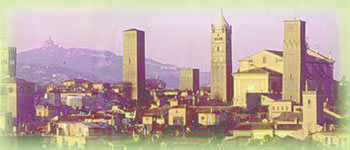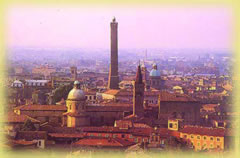For two of
those that have definitely become the symbol of the city, tens and tens of
towers have been lost, and from the twenty or so that have resisted, it is
necessary to search for sites, remains, and traces. The towers of Bologna have
been considered one of the urban element characterizing the city from the 11th
to the 14th century, so much so that it was called the forest of towers. Count
Giovanni Gozzadini, in his monograph on noble Bolognese towers published in
1875, states that, in those times, there existed 180 to 200 of them. He even
provided, for most of them, a name and a description.
 The thing
to do to find the remaining towers and tower houses is to look over the expanse
of rooftops in the centre of the city, since they have been transformed and
incorporated into buildings of following periods. One of them, the Ghisilieri
tower, has become the bell tower of the San Gregorio e Siro church, on
Montegrappa Avenue. Some of the towers, however, fortunately have preserved (or
have recuperated, thanks to knowledgeable and patient restorers) their original
state. Those are the ones that tell us about the Bologna of eight centuries ago,
when families had them built as a sign of wealth and power, but also as
defensive structures, in a period of struggle and very bitter feuds.
The thing
to do to find the remaining towers and tower houses is to look over the expanse
of rooftops in the centre of the city, since they have been transformed and
incorporated into buildings of following periods. One of them, the Ghisilieri
tower, has become the bell tower of the San Gregorio e Siro church, on
Montegrappa Avenue. Some of the towers, however, fortunately have preserved (or
have recuperated, thanks to knowledgeable and patient restorers) their original
state. Those are the ones that tell us about the Bologna of eight centuries ago,
when families had them built as a sign of wealth and power, but also as
defensive structures, in a period of struggle and very bitter feuds.
We
don't want to spend too much time on the two towers - Asinelli and Garisenda -
whose image carries the reputation of Bologna in the world. Rather, let's have a
look at other towers that have survived the fury of battles, the aggression
from the passing of time, and, unfortunately, human ignorance, which brought the
demolition of three of them, at the beginning of 1900. In fact, towers Artemisi,
Guidozagni and Riccadonna stood up a few meters from towers Asinelli and
Garisenda, but were demolished to make space for the new and modern avenues
downtown.
There is no doubt that the most famous and visible ones are towers
Azzoguidi and Prendiparte. The first and tallest one measures 61 meters, and was
also known  as Altabella. It is located on the avenue
bearing its name, at the angle of Caduti di Cefalonia Avenue. It preserved its
majesty with its base covered with ten lines of plaster blocks, and its superior
part made of selenite blocks, the diagonal arch of the ancient door. It was
built in the first half of 1200 by the Guelph Azzoguidi family. The Prendiparte
family, also Guelph, had the Coronata tower built, and it was named like this
because of the crown shape of its top. Elegantly slender (it is 58 meters high),
this one also dates back to the beginning of the 13th century. It still has
its two ancient arched windows, its acute arched door in selenite, and its
base in plaster.
as Altabella. It is located on the avenue
bearing its name, at the angle of Caduti di Cefalonia Avenue. It preserved its
majesty with its base covered with ten lines of plaster blocks, and its superior
part made of selenite blocks, the diagonal arch of the ancient door. It was
built in the first half of 1200 by the Guelph Azzoguidi family. The Prendiparte
family, also Guelph, had the Coronata tower built, and it was named like this
because of the crown shape of its top. Elegantly slender (it is 58 meters high),
this one also dates back to the beginning of the 13th century. It still has
its two ancient arched windows, its acute arched door in selenite, and its
base in plaster.
There are five other towers in Bologna which bring us back to the
Middle Ages: the Galluzzi, in the courtyard of the same name; the Catalani, at
the corner of the alleyway of Spirito Santo; the Conoscenti, in the courtyard of
the Ghisilardi-Fava Palace on 4 Manzoni Avenue; the Guidozagni, hidden in an
intersection of narrow streets, at the beginning of Albiroli Avenue; and the
Uguzzoni, contained and dark in the heart of the ancient Jewish ghetto, on
the corner, between Tubertini and Mandira Streets. The Galuzzi tower, facing the
silent small square, is an example of authentic noble tower with its original
door opening at over six feet from the ground, and presenting obvious traces of
stamping. The Uguzzoni tower is probably the most evocative, not only because it
has been preserved so well, but also because of the complex urban set up in
which it is caught, in an intersection of winding narrow streets and large
picturesque archways. Gozzadini wrote: Entering in the courtyard, circled by
Uguzzoni's ancient tower houses, is like going back many centuries because there
is so much left of the architectural, topographic and dark character of the
Middle Ages.
To the Middle Ages is dedicated the museum in whose elegant
courtyard was rediscovered the tower of Conoscenti, which had remained for
centuries enclosed in the middle of buildings later built. Not only is
it now accessible in all its elements: arches, doors, blocks, but it also
presents an additional source of interest. In fact, its brick wall is attached
to the first walls of the city, dating back to the 5th and 6th century, and is
joined with selenite blocks of the ancient protective walls.
At the
beginning of Santo Stefano Avenue, there is the only survivor of the group of
 towers and tower houses around Asinelli and Garisenda. It is called
Artemisi. It is rich with history and restored to its original thrust, and
presents another link to the past. It is a typical shop with a wooden lock in
the shape of a leaf, and is considered Bologna's oldest shop, dating back to
1273.
towers and tower houses around Asinelli and Garisenda. It is called
Artemisi. It is rich with history and restored to its original thrust, and
presents another link to the past. It is a typical shop with a wooden lock in
the shape of a leaf, and is considered Bologna's oldest shop, dating back to
1273.
And these are the easiest places to discover and marvel at, while in
the centre of the city.
With a little attention and eyes looking up, there
are numerous other evidences of a past rich with history, which can be revealed
to not only tourists but also to Bolognese... who are a little
distracted.
 The thing
to do to find the remaining towers and tower houses is to look over the expanse
of rooftops in the centre of the city, since they have been transformed and
incorporated into buildings of following periods. One of them, the Ghisilieri
tower, has become the bell tower of the San Gregorio e Siro church, on
Montegrappa Avenue. Some of the towers, however, fortunately have preserved (or
have recuperated, thanks to knowledgeable and patient restorers) their original
state. Those are the ones that tell us about the Bologna of eight centuries ago,
when families had them built as a sign of wealth and power, but also as
defensive structures, in a period of struggle and very bitter feuds.
The thing
to do to find the remaining towers and tower houses is to look over the expanse
of rooftops in the centre of the city, since they have been transformed and
incorporated into buildings of following periods. One of them, the Ghisilieri
tower, has become the bell tower of the San Gregorio e Siro church, on
Montegrappa Avenue. Some of the towers, however, fortunately have preserved (or
have recuperated, thanks to knowledgeable and patient restorers) their original
state. Those are the ones that tell us about the Bologna of eight centuries ago,
when families had them built as a sign of wealth and power, but also as
defensive structures, in a period of struggle and very bitter feuds.  as Altabella. It is located on the avenue
bearing its name, at the angle of Caduti di Cefalonia Avenue. It preserved its
majesty with its base covered with ten lines of plaster blocks, and its superior
part made of selenite blocks, the diagonal arch of the ancient door. It was
built in the first half of 1200 by the Guelph Azzoguidi family. The Prendiparte
family, also Guelph, had the Coronata tower built, and it was named like this
because of the crown shape of its top. Elegantly slender (it is 58 meters high),
this one also dates back to the beginning of the 13th century. It still has
its two ancient arched windows, its acute arched door in selenite, and its
base in plaster.
as Altabella. It is located on the avenue
bearing its name, at the angle of Caduti di Cefalonia Avenue. It preserved its
majesty with its base covered with ten lines of plaster blocks, and its superior
part made of selenite blocks, the diagonal arch of the ancient door. It was
built in the first half of 1200 by the Guelph Azzoguidi family. The Prendiparte
family, also Guelph, had the Coronata tower built, and it was named like this
because of the crown shape of its top. Elegantly slender (it is 58 meters high),
this one also dates back to the beginning of the 13th century. It still has
its two ancient arched windows, its acute arched door in selenite, and its
base in plaster.  towers and tower houses around Asinelli and Garisenda. It is called
Artemisi. It is rich with history and restored to its original thrust, and
presents another link to the past. It is a typical shop with a wooden lock in
the shape of a leaf, and is considered Bologna's oldest shop, dating back to
1273.
towers and tower houses around Asinelli and Garisenda. It is called
Artemisi. It is rich with history and restored to its original thrust, and
presents another link to the past. It is a typical shop with a wooden lock in
the shape of a leaf, and is considered Bologna's oldest shop, dating back to
1273.